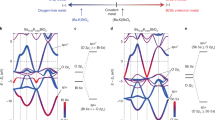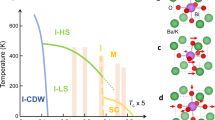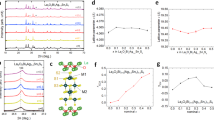Abstract
SUPERCONDUCTING BaPb0.75Bi0.25O3, with a transition temperature (Tc ) of 12 K (ref. 1), is now widely viewed as the precursor to the recent appearance of copper oxide superconductors with record high Tc S. The observation of superconductivity near 30 K in Ba0.6K0.4BiO3 (refs 2,3) has raised serious questions as to whether conventional electron–phonon coupling is the primary pairing mechanism in the bismuth–lead oxide perovskites. Their Tc S are anomalously high, given their low densities of electronic states at the Fermi level4,5, but the debate as to the mechanism of superconductivity is far from settled (see, for example, refs 6–8). Here we report the occurrence of superconductivity at 3.5 K in a new member of the family, BaPb0.75Sb0.25O3. Its Tc , less than one-third that of BaPb0.75Bi0.25O3, is surprisingly low in view of the similarities between the two compounds. The discovery of superconductivity in BaPb0.75Sb0.25O3 establishes a series of isostructural compounds withTc S differing by an order of magnitude. This series provides the basis for further studies to elucidate the essential electronic characteristics that lead to high Tc in the bismuth oxide compounds.
This is a preview of subscription content, access via your institution
Access options
Subscribe to this journal
Receive 51 print issues and online access
$199.00 per year
only $3.90 per issue
Buy this article
- Purchase on Springer Link
- Instant access to full article PDF
Prices may be subject to local taxes which are calculated during checkout
Similar content being viewed by others
References
Sleight, A. W., Gillson, J. L. & Bierstedt, P. E. Solid St. Commun. 17, 27–28 (1975).
Mattheiss, L. F., Gyorgy, E. M. & Johnson, D. W. Jr Phys. Rev. B37, 3745–3746 (1988).
Cava, R. J. et al. Nature 332, 814–816 (1988).
Batlogg, B. Physica 126B, 275–279 (1984).
Kitazawa, K., Uchida, S. & Tanaka, S. Physica 135B, 505 (1985).
Batlogg, B. et al. Phys. Rev. Lett. 61, 1670 (1988).
Hinks, D.G. Richards, D. R., Dabrowski, B., Marx, D. T. & Michelle, A.W. Nature 335, 419–421 (1988).
Varma, C. M. et al. Phys. Rev. Lett. 61, 2713–2716 (1988).
Thanh, T. D., Koma, A. & Tanaka, S. Appl. Phys. 22, 205–212 (1980).
Takagi, H. et al. Solid St. Commun. 55, 1019–1022 (1985).
Bogato, V.V. & Venvtsev, Yu. N. Sov. Phys. Solid. St. 22, 705–706 (1980).
Batlogg, B. et al. in Superconductivity in d and f Band Metals (eds Buckel, W. & Weber, W.) 401–403 (Kernforschungszentrum Karlsruhe GmbH, Karlsruhe, Publs, 1982).
Cox, D. E. & Sleight, A. W. Acta Crystallogr. B35, 1–10 (1979).
Thornton, G. & Jacobson, A. J. Mat. Res. Bull. 11, 837–842 (1976).
Shannon, R. D. & Bierstedt, P. E. J. Am. Ceram. Soc. 53, 635 (1970).
Cox, D. E. & Sleight, A. W. Proc. Conf. on Neutron Scattering, Gatlinburg Tennessee, June 1976 (ed. Moon, R. M.) 45–54 (1976)
Sakhnenko, V. P., Fesenko, E. F., Shuvaev, A. T., Shuvaeva, E. T. & Geguzina, G. A. Sov. Phys. Crystallogr. 17, 268–273 (1972).
Herman, F. & Skillman, S. Atomic Structure Calculations (Prentice Hall, Englewood Cliffs, New Jersey, 1963).
Mattheiss, L. F. & Hamann, D. R. Phys. Rev. B26, 2686–2688 (1982).
Author information
Authors and Affiliations
Rights and permissions
About this article
Cite this article
Cava, R., Batlogg, B., Espinosa, G. et al. Superconductivity at 3.5 K in BaPb0.75Sb0.25O3: why is Tc so low?. Nature 339, 291–293 (1989). https://doi.org/10.1038/339291a0
Received:
Accepted:
Issue Date:
DOI: https://doi.org/10.1038/339291a0
This article is cited by
-
Superconductivity in (Ba,K)SbO3
Nature Materials (2022)
-
Superconducting antimonates
Nature Materials (2022)
-
Synthesis, Structure, and Properties of the Superconductor Ba1−x K z Bi1−y Pb y O 3
Journal of Superconductivity and Novel Magnetism (2015)
-
Organolead halide perovskites: a family of promising semiconductor materials for solar cells
Chinese Science Bulletin (2014)
-
Electrical properties of BaPb1+x−y Sb y O3 ceramics derived from a modified sol-gel method
Journal of Electroceramics (2007)
Comments
By submitting a comment you agree to abide by our Terms and Community Guidelines. If you find something abusive or that does not comply with our terms or guidelines please flag it as inappropriate.



